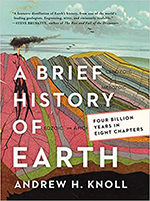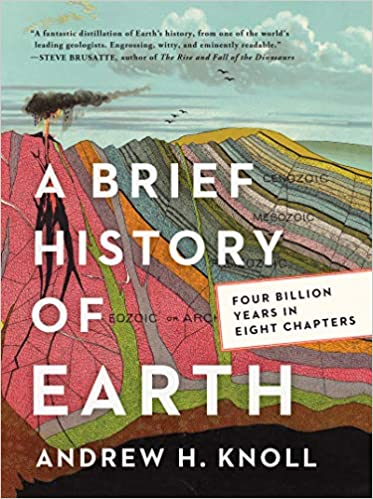 Andy Knoll wrote a masterful, fascinating book in 2003, Life on a Young Planet. Now, 18 long years later, he’s published another popular science volume, an eight-chapter encapsulation of our planet’s story. I don’t know why he’s waited so long (busy doing science, I guess) but he really does have a talent for telling geobiological stories in a full but accessible way. Knoll is a paleontologist, and the great theme he explores in Earth’s biography is the interaction between the nonliving and living portions of the planet. The volume is organized chronologically, starting with 30 pages on the chemical processes that developed in the condensation of the presolar nebula, then moving into the physical processes that organized the planet into layers and triggered motions in some of those layers, into the origins of life, and the rise of oxygen. Animals and plants get a chapter each, which leaves one for a discussion of singular catastrophes (LIPs, extraterrestrial impacts) that interrupt the flow of evolution, and the human influence of natural systems after that. Knoll draws a parallel between the end-Permian mass extinction and the current “Anthropocene” suite of changes in the planet, concluding that the next chapter in the saga is up to us all, collectively, to write.
Andy Knoll wrote a masterful, fascinating book in 2003, Life on a Young Planet. Now, 18 long years later, he’s published another popular science volume, an eight-chapter encapsulation of our planet’s story. I don’t know why he’s waited so long (busy doing science, I guess) but he really does have a talent for telling geobiological stories in a full but accessible way. Knoll is a paleontologist, and the great theme he explores in Earth’s biography is the interaction between the nonliving and living portions of the planet. The volume is organized chronologically, starting with 30 pages on the chemical processes that developed in the condensation of the presolar nebula, then moving into the physical processes that organized the planet into layers and triggered motions in some of those layers, into the origins of life, and the rise of oxygen. Animals and plants get a chapter each, which leaves one for a discussion of singular catastrophes (LIPs, extraterrestrial impacts) that interrupt the flow of evolution, and the human influence of natural systems after that. Knoll draws a parallel between the end-Permian mass extinction and the current “Anthropocene” suite of changes in the planet, concluding that the next chapter in the saga is up to us all, collectively, to write.


I have both of these in my wish list.. Since you said the first book was masterful and fascinating.. I’ll start with that one.. It’s funny I used to have a ‘book age’ bias when it came to science.. I only wanted the newest information.. On the Origin of Species cured me of that.. It was everything I hoped high school evolution class would be, but wasn’t. Life on a young planet isn’t that old of course, but I think you know what I mean.. Anyway.. Thanks for the recommendation.
“Life on a young planet” in a great example of “how we know what we know” science writing. Knoll takes you to the rocks, in Siberia, Canada, Namibia, Australia, China and Spitsbergen. He talks with the scientists working the sites, and the scientists doing the less glamorous work in labs. He relates the facts and the less settled parts, cleanly separating his opinions from consensus, when they differ. The book includes color plates, black and white photos and both original and borrowed graphics. Charts of genealogical relationships between eukaryotic aganisms, between chloroplasts, two slightly differently versions of the “Tree of Life” showing Bacteria, Archaea and Eukarya groupings and the families they contain. This based on sequence comparisons of genes that code for RNA in ribosomes. On the 6th or 10th reading, it’s nice to use the different illustrations to be sure one understands the text. Repeat readings are needed to comprehend the wide scope of the subject. The writing is clean, clear and informative.